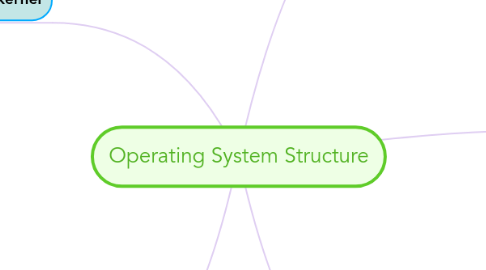
1. Layered Approach
1.1. OS is divided in to numbers of layers.
1.2. Advantage
1.2.1. Simplicity of construction and debugging
1.3. Disadvantages
1.3.1. The careful definition and interaction of the layers.
1.3.2. Less efficient
2. Microkernel
2.1. Small operating system core
2.2. many services are now external subsystems
2.2.1. device drivers
2.2.2. file systems
2.2.3. virtual memory manager
2.2.4. windowing system
2.2.5. security services
2.3. benefits
2.3.1. extensibility
2.3.1.1. allows the addition of new services
2.3.2. flexibility
2.3.2.1. new features added
2.3.3. reliability
2.3.3.1. modular design
2.3.4. protability
2.3.4.1. a new processor is changed in the microkernel
3. Operating System Services
3.1. User interface
3.1.1. All OS have a user interface
3.2. Program execution
3.2.1. to load a program into memory and to run that program, end execution.
3.3. I/O operations
3.3.1. Since user programs cannot execute I/O operations directly, the operating system must provide some means to perform I/O.
3.4. File-system manipulation
3.4.1. Program capabilities to read and write files and directories, create and delete them, search them, list file Information, permission management.
3.5. Communications
3.5.1. Processes may exchange information, on the computer.
3.6. Error detection
3.6.1. Ensure correct computing by detecting errors in the CPU and memory hardware, in I/O devices, or in user programs.
4. Additional Operating System Functions
4.1. 3 general methods to pass parameters between program and OS.
4.2. Resource allocation – allocating resources to multiple users or multiple jobs running at the same time.
4.3. Protection and security - store information
5. System Calls
5.1. provide interface between a running program and the OS.
5.2. types of system calls
5.2.1. process control
5.2.2. file management
5.2.3. deivce management
5.2.4. information maintenance
5.2.5. communications
5.2.6. protection

